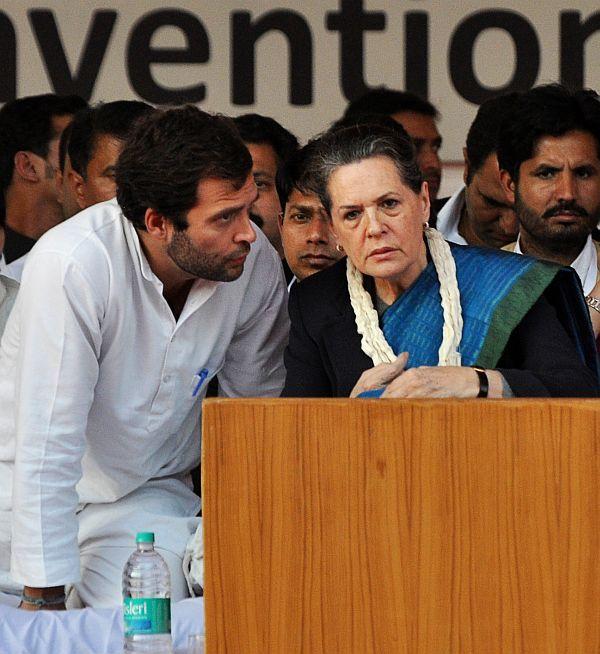
Rahul Gandhi is no Sonia Gandhi or Indira Gandhi to revive the party but the Congress president too needs to share the blame for the current state of affairs and the party’s debacle, says Saroj Nagi.
The Congress finds itself in a deep morass after the body blow it received in Delhi, Rajasthan, Madhya Pradesh and Chhattisgarh. It is now left to the top leadership -- which has failed the party -- to try and resurrect its fortunes. The task is daunting and perhaps even unachievable ahead of the 2014 Lok Sabha elections as the party has to pay the price of incumbency of two terms at the Centre, allegations of corruption and mal-governance and failure to deal with inflation among other things.
The battle of restoring the party’s fortunes would have to be carried to another day.
But the big question is whether the two top leaders of the Congress -- party president Sonia Gandhi and vice president Rahul Gandhi -- can do so.
Unlike Rahul, Sonia still enjoys a lot of credibility with the party and the people. But she is increasingly being handicapped by her age -- she is 67 now -- her undisclosed illness and her determination to hand over the mantle to Rahul whose track record since his entry into active politics hasn’t been much to write about in terms of reinventing the party, reviving the party’s fortunes in states like Uttar Pradesh and Bihar or for that matter West Bengal and Tamil Nadu which between them contribute nearly 201 seats to theLok Sabha or even holding on to its flanks.
And Rahul is no Sonia or Indira Gandhi, the two leaders who had extricated the party from the mess it had found itself in.
The author is a senior journalist based in Delhi.
Please click NEXT to read further…
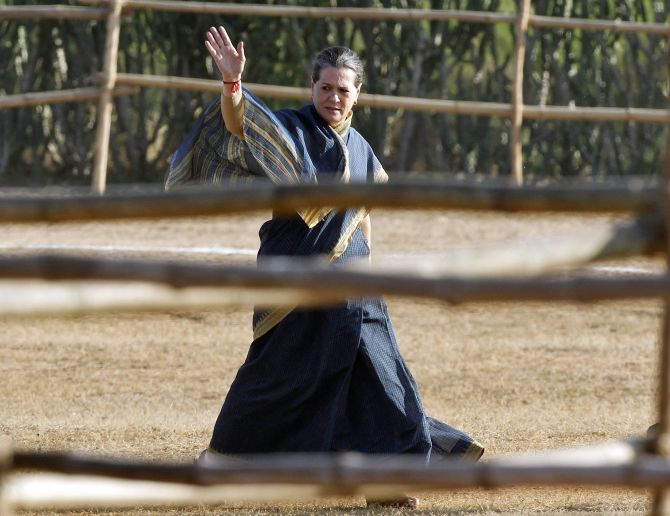
There is a growing demand from within the party for Sonia to step up and take the lead once more and repeat the feat she did of transforming the party and bringing it to power. She took charge of the party at a time when it was in the dumps burdened with allegations of corruption, a badly-dented image and with little social and political base and appeal.
She fought against all odds, battling opposition over her foreign origin, criticism over her inadequate knowledge of Hindi and ridicule of being “a reader rather than a leader’’ -- much like the ‘gungi gudiya’ (dumb doll) sobriquet invested on her mother-in-law before her anointment as ‘Durga’ -- to turn around the party.
Sonia gave it a Left-ward tilt to it with her slogan of Congress ka haath aam aadmi ke saath, shed its ‘go it alone’ policy, struck up alliances with non-BJP parties and hoisted the Congress to power as the head of its first coalition government at the Centre in 2004.
In doing so, she had modeled herself on her mother-in-law and former prime minister Indira Gandhi in her sartorial behaviour, mannerisms and politics, particularly when she reworked the latter’s war cry of garibi hatao (remove poverty) to an inclusive slogan of Congress ka haath, aam aadmi ke saath (The Congress hand is with the common man).
To top it all, she renounced the prime minister’s post, earning for herself a stature that dwarfed all her rivals who began to be seen as power hungry.
In short, she displayed firmness in adversity, determination in achieving her objective and flexibility in working towards that goal much like Indira who fought off the powerful syndicate, split the party, took the opposition head-on with her call of garibi hatao and her clinching argument “woh kehte hain Indira hatao, main kehti hoon garibi hatao” (they say remove Indira, I say remove poverty) and established herself as the supreme leader by liberating Bangladesh and standing up against the United States. And though she suffered a huge setback after the Emergency she stormed back to power in 1980 after the collapse of an unstable Janata Party regime.
Can Rahul now replicate his mother’s efforts and achievements?
Not many would give him even the benefit of doubt.
Please click NEXT to read further…
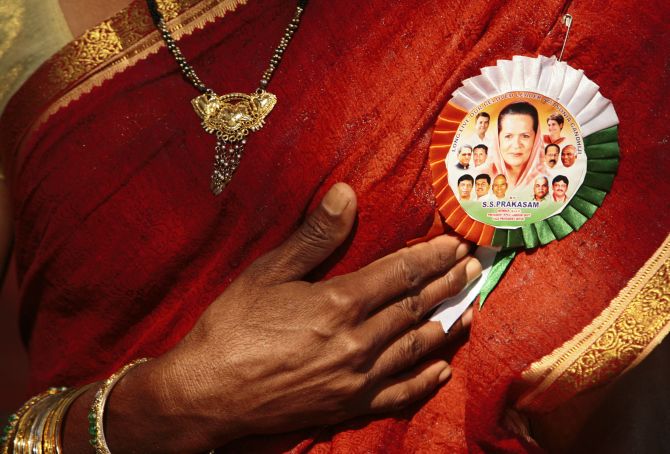
It is not as if Sonia has not had her share of faults though on balance her achievements would perhaps outweigh her failures.
First, she has failed to focus on the organisation taking her time to make state-level changes, among other things.
She succeeded in giving the Congress 10 years of power at the Centre. But she failed to use the opportunity to strengthen the party in states where it has been floundering for several years now including Uttar Pradesh, Bihar, West Bengal, Tamil Nadu and even Gujarat where the Bharatiya Janata Party’s present prime ministerial candidate has effectively pushed her party to the margins.
Despite her repeated appeals to her party colleagues to address this problem, the organisation remains stuck in the quagmire, sinking gradually, despite the faint hope delivered during the 2009 Lok Sabha elections in UP when the party won 21 seats.
Now there is the added danger that the three-time victories of the BJP in Madhya Pradesh and Chhattisgarh could turn out to be another barren land for the party like in UP, Bihar or Gujarat.
Second, the move to hand over charge to Rahul is not paying dividends.
Part of the failure to strengthen the organisation is attributed to the fact that the Congress’s victory in 2004 coincided with Rahul’s entry into active politics. In the initial days, the Congress president was busy in steering the government towards a pro-people approach through the National Advisory Council. But over the months, she began to give Rahul a greater role in the organisation as general secretary in charge of frontal organizations, and after 2009 as a star campaigner and since January 2013 as vice-president and main campaigner for the elections and the main strategist for 2014.
Rahul remained and remains a learner -- first by touring the country and learning first hand the problems: be it of farmers or Dalits and then ‘learning’ from the resounding victory of the Aam Aadmi Party in Delhi.
Please click NEXT to read further…
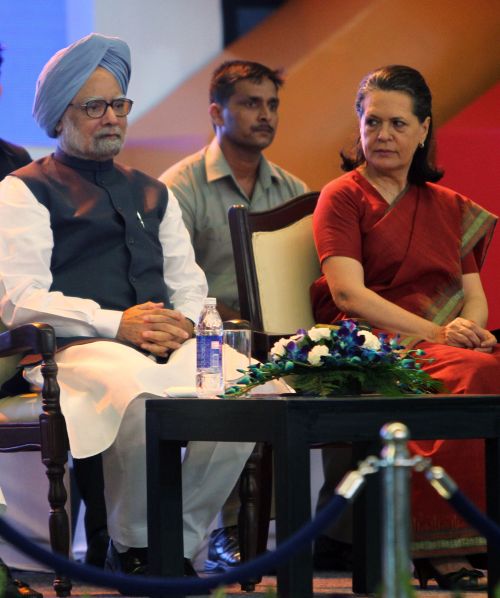
Third, the division of responsibility of political and government work between her and Prime Minister Manmohan Singh has been a mixed bag. It worked well in United Progressive Alliance-I when things were under control; in UPA-I it is collapsing. Despite the public front that ‘all is well’ between the two leaders, there have been reports of differences between the two right from the word go in UPA-II -- the Sharm el-Shaikh episode when the Indo-Pakistan joint statement included a reference to Baluchistan, the question of talks with Pakistan in the backdrop of the Mumbai terror strike or the government’s desire to change the right to information act.
It isn’t that there were no differences in UPA-1. But these were managed maturely, be it the issue of disinvestment which had upset the Dravida Munnetra Kazhagam and the Left parties -- which later in 2008 pulled out support over the Indo-US civil nuclear deal.
Then there has been a marked failure to build a mechanism for consultations which could act as a bridgehead between the party, the government, the allies and the people. UPA-I had such a mechanism: there was a UPA coordination committee with allies on board; the PM and Sonia had a core committee which acted as a bridge between the top leaders of the government and the organisation and discussed key issues to be brought before the Cabinet; and the National Advisory Council, which Sonia presided, brought the civil society into the frame of governance.
But the one key missing link was the complete absence of a bridgehead between the ministers and the party workers who often complained that those who they helped get elect would refuse to meet or hear them.
Please click NEXT to read further…

Four, there has been almost a complete absence of discussion on key and burning issues agitating the party. And even when discussion has been held, there has been little redressal of the issue. The Congress Working Committee meetings are few and far between and generally called to pass condolence resolutions. And when called to deliberate on issues like price rise, inflation or corruption -- which has hit the party hard in the recent state polls -- there has been little progress.
At the AICC plenary session at Burari in 2010 Sonia laid out a roadmap for tackling corruption but it could not insulate the party from the charges of graft, with the allegations on coal scam even reaching the prime minister’s doorstep. There was no evidence of any forward movement since the samvad baithak (dialogue session) in Surajkund in November 2012 with regard to dealing with the manifold economic and political challenges before the party.
And the brainstorming session at Jaipur in January 2013 turned out to be a mega-emotional show for anointing Rahul as party vice-president.
So in a way, if Rahul has earned his place because of dynastic politics, he has also inherited the party’s challenges and shortcomings.
Can he now help surmount these challenges and plug the shortcomings?
It is a gigantic task. More so, as his political balance sheet shows an unhealthy graph.
Please click NEXT to read further…
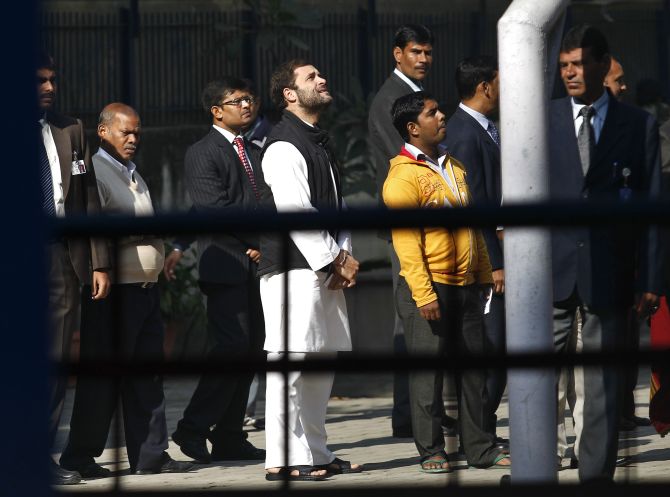
One of the core lessons in marketing and management is the emphasis on continual reinvention when the stakes are high and the chips are down.
The Congress vice-president, who has promised to transform the Congress, needs to first change and transform himself. He has to identify his failings and reinvent himself accordingly.
He needs to focus on the ‘three Cs’ that leaders have begun to talk about to restore the party’s standing in Indian politics -- communication, campaign and candidates. “These three Cs include everything,” said a leader who did not want to be named
For a leader, who was once touted as a youth icon, Rahul lacks cadre-and-people connect, reducing politics to a set paradigm with his clinical approach of selecting workers, candidates and leaders through a computer-generated constituency-based data sheet. If Rahul has to draw a lesson, as he said he would, from AAP’s stunning victory in Delhi, he has to be available, accessible and approachable.
It is a lesson for him that it is not enough to claim to have come up with pro-people programmes like food security but also to ensure their delivery and perhaps more importantly to signal that he and other Congress leaders are also pro-people in their attitude, behaviour and dispensation. They cannot merely peep out from their ivory towers; they must be reachable and available and he cannot make a guest appearance in politics, choosing to vanish as suddenly as he descends on the field.
Party workers and leaders complain that the pleas for a meeting with Rahul remain unanswered and if and when they meet, they are unsure whether they have registered their presence with him. Unlike Indira who knew her workers or Sonia who could strike an emotional chord with the rural poor, Rahul is seen to be impatient, aloof and distant, little heard and little seen either in Parliament or in public (unless it is election time) or for that matter in the lower rungs of the Congress circles.
Please click NEXT to read further…
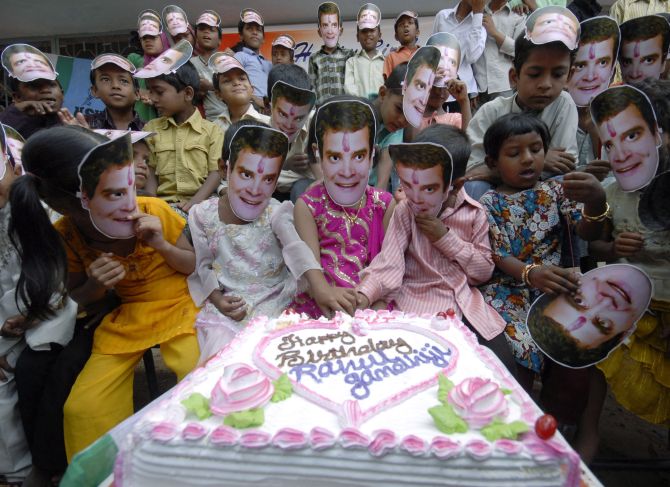
Though he stayed in Dalit homes and identified himself with the agitating farmers in UP’s Bhatta Parsaul and the tribals of Niyamgiri hills in Odisha, these have been sporadic episodes. He is often not around when he should be as, for instance, when the youths were out on the streets in anger and anguish over the brutal rape of a young paramedic last December and were looking for solace and reassurance of safety from the political class or when they agitated with Anna Hazare for the Jan Lokpal bill.
And even when he tried to identify with the public outcry against the ordinance which intended to shield convicted lawmakers, he did it in an immature manner instead of approaching the prime minister with his objection. He barged into a press conference, trashed as ‘nonsense’ the draft ordinance that had been cleared by the Cabinet, the core committee (of which Sonia is also a part) and the allies and in doing so stripped the prime minister of whatever little authority he had been left with.
His communication skills remain a matter of controversy, with BJP’s Narendra Modi and AAP way ahead of him in using the social media in networking with their supporters.
Please click NEXT to read further…
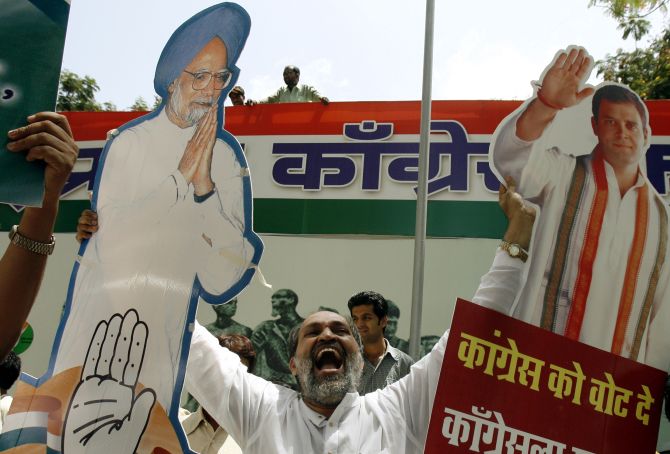
Much needs to be done with the second C -- the party’s campaign -- both in terms of its form and content. Rahul chose to talk more about his mother’s tears, the Gandhi family’s sacrifices and the threat to his life or dwell on the threats from Modi and the BJP rather than connect with the aspirations and expectations of the people and the voters. In doing so, he went against his own dictum: that party leaders and workers should focus on the Congress’s positives and the UPA’s achievements to give a new thrust to politics.
With UPA-II not even a pale shadow of UPA-I, Rahul would have perhaps found it difficult to stick by his own guidelines. But even when it came to state governments, he and Sonia chose to attack Modi rather than elaborate on Ashok Gehlot’s pro-people schemes and given the poor response of the people to Rahul’s rally in Delhi left it to Sheila Dikshit to fight her own battle.
Insofar as the state leadership was concerned, the Congress remained a house divided in Madhya Pradesh, Chhattisgarh, Delhi and Rajasthan -- a bane that the party has not been able to deal with.
The third ‘C’, candidate covers issues like the choice of candidate, the manner of selection and who selects the nominees for the polls. It is a sensitive task that requires sagacity, political management and an understanding not just of the organisation but also of the state and the region where the election has to be fought.
In the case of the recent assembly elections, the task of preparing for the polls was entrusted to inexperienced organisational hands including Madhusudan Mistry, Shakeel Ahmed, Gurudas Kamat and former socialist Mohan Prakash who could not check factionalism and groupism or ensure proper ticket distribution so much so that even Rahul’s promise to clean up the Congress camp of tainted candidates was compromised as for instance when family members of those accused of involvement in the Bhanwari Devi case were given tickets in Rajasthan.
It is a tall order for the Amethi MP who has still not graduated from becoming a learner to a leader; he has no option but to transform himself and deliver -- even if it means losing an election or two -- lest he be relegated to the margins by newer and more vigorous forces.

Click on MORE to see another PHOTO features...